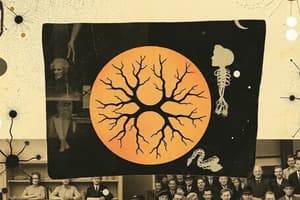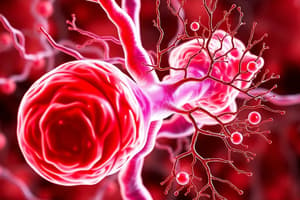Podcast
Questions and Answers
What is the purpose of the electron transport chain in cellular respiration?
What is the purpose of the electron transport chain in cellular respiration?
- To reduce oxygen to form water
- To synthesize NADH and FADH2
- To generate ATP through the breakdown of glucose
- To pump protons out of the matrix and create a gradient (correct)
What is the byproduct of oxygen accepting electrons at the end of the electron transport chain?
What is the byproduct of oxygen accepting electrons at the end of the electron transport chain?
- ATP
- Water (correct)
- Carbon dioxide
- NADH
Which stage of cellular respiration can occur in the absence of oxygen?
Which stage of cellular respiration can occur in the absence of oxygen?
- Pyruvate oxidation
- Glycolysis (correct)
- Oxidative phosphorylation
- The citric acid cycle
What is the role of ATP synthase in cellular respiration?
What is the role of ATP synthase in cellular respiration?
Which stages of cellular respiration require oxygen?
Which stages of cellular respiration require oxygen?
What is the primary function of the electron transport chain in oxidative phosphorylation?
What is the primary function of the electron transport chain in oxidative phosphorylation?
What is the byproduct of pyruvate oxidation in the mitochondrial matrix?
What is the byproduct of pyruvate oxidation in the mitochondrial matrix?
What is the role of electron carriers in the electron transport chain?
What is the role of electron carriers in the electron transport chain?
What is the end product of glycolysis?
What is the end product of glycolysis?
What is the function of Coenzyme A in pyruvate oxidation?
What is the function of Coenzyme A in pyruvate oxidation?
What is the primary site of ATP production during cellular respiration?
What is the primary site of ATP production during cellular respiration?
What is the byproduct of the citric acid cycle?
What is the byproduct of the citric acid cycle?
What is the role of the mitochondrial matrix in cellular respiration?
What is the role of the mitochondrial matrix in cellular respiration?
Flashcards are hidden until you start studying
Study Notes
Cellular Respiration
- Cellular respiration is the process of breaking down glucose into carbon dioxide and water, producing ATP along the way.
- ATP is produced directly in the reactions that transform glucose, and more ATP is produced later in oxidative phosphorylation.
Oxidative Phosphorylation
- Oxidative phosphorylation is powered by the movement of electrons through the electron transport chain, a series of proteins embedded in the inner mitochondrial membrane.
- Electrons come from glucose and are shuttled to the electron transport chain by electron carriers, which become reduced when they gain electrons.
The Four Stages of Cellular Respiration
- Glycolysis: glucose is converted into two molecules of pyruvate, a three-carbon organic molecule, producing ATP and NADH.
- Pyruvate Oxidation: pyruvate is converted into a two-carbon molecule bound to Coenzyme A, releasing carbon dioxide and generating NADH and FADH2.
- Citric Acid Cycle: acetyl CoA combines with a four-carbon molecule, producing ATP, NADH, FADH2, and releasing carbon dioxide.
- Oxidative Phosphorylation: electrons from NADH and FADH2 deposit their electrons in the electron transport chain, producing ATP and water.
Additional Key Facts
- Fermentation is a process that can occur without oxygen, where glycolysis takes place.
- The other three stages of cellular respiration – pyruvate oxidation, citric acid cycle, and oxidative phosphorylation – require oxygen to occur.
- Only oxidative phosphorylation uses oxygen directly, but the other two stages can't run without oxidative phosphorylation.
Studying That Suits You
Use AI to generate personalized quizzes and flashcards to suit your learning preferences.




